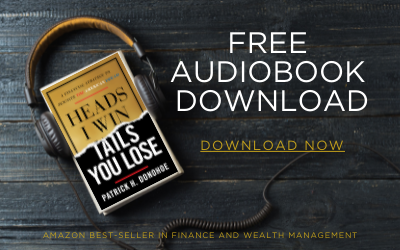For many Americans, home equity is their largest store of untapped wealth. Yet too often, that value remains locked in place—accumulating on paper, but not actively contributing to cash flow or long-term financial freedom.
But what if you could strategically unlock that equity to build wealth—without compromising your financial stability or risking your future?
Knowing how to use home equity to build wealth isn’t about “borrowing to spend.” It’s about transforming idle value into a productive, purpose-driven asset—one that fits seamlessly into your broader financial strategy.
At Paradigm Life, we believe that home equity, when used correctly, can:
- Strengthen your cash flow
- Create new investment opportunities
- Enhance flexibility across life phases
- Support your long-term legacy
But there’s a critical distinction: Leveraging equity must align with your values, your goals, and your risk profile—not just market opportunity.
Understanding Home Equity: More Than Just Value on Paper

Many homeowners think of home equity as something static—a number on a statement that gradually increases as they pay down their mortgage or as market values rise. While that’s true on the surface, this perspective dramatically underutilized what can be one of your most powerful financial tools.
Home equity is not just value—it’s potential. When approached strategically, it can become an active, productive part of your wealth-building system.
What Is Home Equity?
At its core, home equity is simply the difference between your home’s market value and the amount you still owe on your mortgage. The more you pay down your loan—or the more your property appreciates—the larger your equity becomes.
Yet the traditional mindset has been: “Sit on it. Let it grow. Eventually, maybe tap it in retirement or when selling.”
But why wait, when that value could be working for you now—in ways that support your broader financial goals?
Equity Within Your Hierarchy of Wealth™
In The Perpetual Wealth Strategy™, not all assets are viewed equally. We organize them using the Hierarchy of Wealth™, based on three criteria:
- Liquidity
- Risk
- Control
Home equity is a Tier 2 asset:
- It is relatively stable and can support wealth building,
- But it is illiquid unless strategically accessed (through tools like HELOCs, loans, or refinancing),
- And it is subject to market forces (property value fluctuations, interest rates).
That’s why leveraging home equity should always be paired with Tier 1 assets—such as properly structured Whole Life Insurance—to create liquidity, mitigate risk, and provide flexibility.
Equity as a Source of Financial Velocity
A home that is 50%, 70%, or even 90% paid off represents trapped capital if the equity sits idle. When used intentionally, this capital can fuel:
- New income-producing investments
- Business opportunities
- Portfolio diversification
- Liquidity buffers to weather market volatility
The key is using it with a strategy—not to spend, but to build.
This is an opportunity to take something you already own—your home—and transform it from passive value into an active, integrated wealth-building tool that supports your entire financial ecosystem.
How to Use Home Equity to Build Wealth

Now that you understand the potential of home equity as a wealth-building tool, the next step is knowing how to unlock and deploy it strategically. This is where careful planning becomes essential. The goal is not simply to access equity for the sake of leverage, but to do so in a way that aligns with your overall wealth strategy, safeguards your cash flow, and protects your future.
The following are primary ways to access and use home equity as part of an integrated wealth-building approach.
Accessing Your Equity: Common Tools
There are several financial tools available to access home equity, each with unique characteristics:
- Home equity loan (HEL): A fixed-term loan that allows you to borrow a lump sum against your equity. It typically has a fixed interest rate and is repaid over a set number of years.
- Home equity line of credit (HELOC): A revolving line of credit, similar to a credit card, secured by your home equity. You can draw from it as needed and only pay interest on the amounts used.
- Cash-out refinance: A refinancing of your primary mortgage where you replace your existing loan with a new, larger loan and receive the difference in cash.
Each of these tools can unlock your home equity, but choosing the right one depends on your goals, risk tolerance, and financial phase. The decision must fit within a system designed to optimize cash flow and protection, not compromise it.
Aligning Equity Use with Purpose
Using home equity to build wealth is not about chasing the highest returns. It’s about creating stability and sustainable growth. Here are examples of how equity can be used purposefully:
- Investing in cash-flowing real estate: Deploying equity to purchase income-producing properties can create additional cash flow streams. However, this should be done with careful attention to market conditions, financing terms, and cash flow projections.
- Funding business opportunities: In some cases, home equity can be used to seed or expand a business. This requires rigorous planning, as business ventures carry inherent risk. The key is to ensure that debt service will not impair personal cash flow.
- Building passive income streams: Equity can also be used to diversify income sources, such as through dividend-producing assets, private lending, or other structured opportunities.
- Integrating with Whole Life Insurance: By pairing home equity strategies with Whole Life Insurance, you create a system that enhances both liquidity and risk protection. Cash value from your policy can serve as an emergency buffer or as a source of funds to help manage leverage-related cash flow. This is how you build resilience into your plan, rather than relying solely on market timing or property appreciation.
Protecting the Foundation
Leveraging home equity must always prioritize cash flow and protection first.
Without a strategic buffer, such as a Wealth Maximization Account or properly structured reserves, homeowners can find themselves exposed if interest rates rise, property values decline, or personal income fluctuates.
In The Perpetual Wealth Strategy™, this principle is paramount: use leverage to enhance, not replace, the foundation of your financial security.
Building Wealth Through Home Equity: Core Strategies

Once you have clarity on how to access your home equity, the next step is to determine how to deploy it strategically. In a world of options, discernment is key. Not every opportunity aligns with a sound wealth-building philosophy. The right strategies must prioritize cash flow, protection, and sustainable long-term growth — the very pillars of The Perpetual Wealth Strategy™.
Here are several effective approaches for building wealth with home equity:
Using Home Equity to Acquire Income-Producing Real Estate
One of the most common ways to put home equity to work is by using it to purchase additional real estate — specifically, assets that generate reliable cash flow. These might include rental properties, multi-family units, or even select commercial spaces.
The advantage is clear: instead of sitting idle, your home equity is transformed into an income stream. But the decision must be grounded in solid analysis:
- Will the rental income exceed the carrying costs of both the property and the leveraged equity?
- Does the new property strengthen your overall cash flow?
- How does this fit into your Hierarchy of Wealth™, balancing risk and control?
When paired with a Whole Life policy, this strategy is strengthened further — providing liquidity to handle vacancies or repairs without disrupting other parts of your personal economy.
Using Home Equity to Fund or Expand a Business
For entrepreneurs, leveraging home equity can serve as a source of startup or expansion capital. It can allow you to move forward without diluting ownership or taking on high-interest unsecured debt.
That said, this is an advanced strategy and should only be considered when:
- The business has clear cash flow projections.
- Personal and business finances are protected.
- The risk to your primary residence is clearly understood.
Integrating Whole Life Insurance here provides a key benefit: it ensures that if life or business conditions change, you have a non-correlated liquidity source to navigate challenges.
Using Home Equity to Create Passive Income Streams
Beyond real estate or business, home equity can also fund investments designed to create passive income — such as dividend-paying assets, private lending, or alternative investments. The principle remains the same: cash flow first, with control and liquidity preserved.
In this approach, coordination with Whole Life Insurance is especially important. Your policy’s cash value can serve as an operating reserve or a holding place for income between investments, adding a layer of stability to the system.
The Role of Tax Efficiency
Many homeowners overlook the tax implications of using home equity. When properly structured, interest on home equity borrowing may offer deductions — particularly when funds are used for investment or business purposes.
Likewise, pairing equity strategies with tax-advantaged assets such as Whole Life Insurance enhances overall tax efficiency — protecting more of what you earn and build.
Strategic Home Equity Use: Best Practices

Accessing and using home equity can be a powerful way to build wealth — but like any financial tool, it carries both opportunity and responsibility. The key is to ensure that your use of home equity is not only effective, but also safe, sustainable, and aligned with your broader goals.
In The Perpetual Wealth Strategy™, this is where intentionality comes in. Equity should serve your financial life — not dictate it. The following best practices help ensure that you stay in control of the process.
Protect Cash Flow First
The foundation of any sound wealth strategy is positive, predictable cash flow. Before deploying home equity:
- Verify that your monthly obligations — including any new debt service — will be manageable under both current and potential future conditions (such as rising interest rates or market shifts).
- Ensure that new investments funded by equity are cash-flow positive from the outset.
- Use Whole Life Insurance to create an additional liquidity buffer that supports cash flow even if unexpected events arise.
In short: cash flow first, growth second — a principle that protects both lifestyle and financial stability.
Avoid Overleveraging
A common pitfall with home equity is the temptation to borrow too aggressively — especially in a rising property market. It’s important to remember that real estate cycles shift, and leverage magnifies both gains and losses.
Best practice here is to:
- Keep sufficient equity in your primary residence to avoid becoming “house poor.”
- Limit your debt-to-value ratios on both personal and investment properties.
- Maintain Tier 1 liquidity through Whole Life cash value so that you are never forced to sell assets or refinance under unfavorable conditions.
Leverage can accelerate growth — but only when managed within a system that prioritizes resilience.
Maintain Liquidity and Optionality
One of the risks of using home equity is that it is not inherently liquid — once deployed, it may take time to access again or unwind. To counter this:
- Pair home equity strategies with Whole Life Insurance, which provides a ready source of non-correlated liquidity.
- Build cash reserves alongside leveraged investments.
- Avoid committing all equity to illiquid assets — keep a margin of safety.
Liquidity enhances optionality — your ability to adapt, respond to opportunity, or manage through volatility without being cornered.
Understand When Not to Use Home Equity
Perhaps most importantly, strategic use of home equity also means knowing when not to use it. Caution is warranted when:
- Personal cash flow is already tight.
- Employment or income sources are uncertain.
- The planned use of funds is speculative or lacks clear return on investment.
- There is insufficient Tier 1 liquidity to support risk management.
In such cases, it is wiser to build your financial foundation first — then leverage from a position of strength.
To build a complete, resilient wealth strategy, it’s important to see how home equity fits alongside other key pillars of your financial life. If you’re exploring ways to create additional income streams, this guide on real estate passive income offers valuable insights.
For those thinking ahead to legacy, the estate planning checklist can help ensure your wealth transfers as intended. And if you’re a business owner, the family business succession planning resource provides actionable steps to protect and transition your enterprise.
FAQs About How to Use Home Equity to Build Wealth
How to turn equity into income?
You can access home equity through a loan, HELOC, or refinance, and deploy it into income-producing assets such as rental properties or dividend-generating investments — always ensuring the cash flow exceeds borrowing costs and supports your overall financial strategy.
How much home equity do most Americans have?
On average, U.S. homeowners with a mortgage hold about $300,000 to $350,000 in home equity, though many do not actively leverage this value as part of an integrated wealth strategy.
Can you use home equity to pay off a mortgage?
Yes, through a cash-out refinance, but this should be weighed carefully — as paying down a low-interest mortgage may not be the most efficient use of equity compared to investing it in assets that generate stronger returns.
Should I use home equity for real estate or other investments?
When used strategically, home equity can fund real estate or diversified investments that generate consistent income; however, it’s critical to manage risk, protect liquidity, and ensure alignment with your broader financial system.
Build a Wealth Strategy That Works for Life
Using home equity to build wealth is not about chasing returns — it’s about creating a purposeful, resilient financial system that supports your life today and your legacy tomorrow. When integrated with tools like Whole Life Insurance and guided by the principles of The Perpetual Wealth Strategy™, your home equity becomes a dynamic asset — fueling cash flow, enhancing protection, and positioning you for long-term success.
If you’re ready to explore how this strategy can work in your financial life, we invite you to schedule a conversation with a Paradigm Life Wealth Strategist. Together, we’ll help you design a system that grows, protects, and adapts — no matter what the market does.







